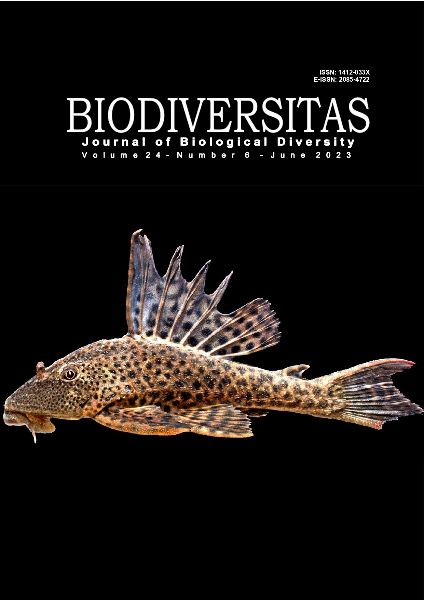New corn resistant lines to stalk rot disease (Dickeya zeae) in Indonesia
##plugins.themes.bootstrap3.article.main##
Abstract
Abstract. Suriani, Patandjengi B, Muis A, Junaid M, Mirsam H, Azrai M, Efendi R, Sebayang A. 2023. New corn resistant lines to stalk rot disease (Dickeya zeae) in Indonesia. Biodiveritas 24: 3190-3200. Stalk rot disease caused by Dickeya zeae is one of the important diseases of corn in Indonesia. Host resistance cultivars are an effective and sustainable control measure of the disease. Therefore, the present study aimed to evaluate the resistance of 15 S1 hybrid maize lines to stalk rot disease. The research was conducted in two seasons (DS and WS) using a randomized block design with 3 replications. The D. zeae suspension with 108cfu/mL concentration was inoculated into the plant test 45 Days After Planting (DAP). Disease incidence and severity were observed during the two seasons. The results showed that all tested lines were infected with stalk rot disease but had various resistance reactions. Disease incidence and severity in the dry season were higher than in the rainy season. In the rainy season all test lines followed the 3 models of disease development, but in the dry season, all lines followed the monomolecular model. Further analysis showed that 3 lines of hybrid maize had the lowest AUDPC value with a protection index of more than 50% in two growing seasons. Stalk lignin content had negative correlation with a disease incidence of -0.60877, so it can be used as a parameter of plant resistance to disease. Tested lines that show resistance to the disease could potentially be useful as new varieties of maize.
##plugins.themes.bootstrap3.article.details##
Most read articles by the same author(s)
- NUR FADHLI, MUH. FARID, RAFIUDDIN, ROY EFFENDI, MUHAMMAD AZRAI, MUHAMMAD FUAD ANSHORI, Multivariate analysis to determine secondary characters in selecting adaptive hybrid corn lines under drought stress , Biodiversitas Journal of Biological Diversity: Vol. 21 No. 8 (2020)
- SUKMAWATI, AMBO ALA, BAHARUDDIN PATANDJENGI, SIKSTUS GUSLI, Exploring of promising bacteria from the rhizosphere of maize, cocoa and lamtoro , Biodiversitas Journal of Biological Diversity: Vol. 21 No. 12 (2020)
- MUHAMMAD JUNAID, DAVID GUEST, Modified culture assay to obtain a diversity of hyphal structures of Ceratobasidium theobromae-VSD pathogen on cocoa , Biodiversitas Journal of Biological Diversity: Vol. 22 No. 4 (2021)
- HISHAR MIRSAM, AMRAN MUIS, NURNINA NONCI , The density and diversity of plant-parasitic nematodes associated with maize rhizosphere in Malakaji Highland, South Sulawesi, Indonesia , Biodiversitas Journal of Biological Diversity: Vol. 21 No. 6 (2020)
- NUR FADHLI, MUH FARID, MUHAMMAD AZRAI, AMIN NUR, ROY EFENDI, SLAMET BAMBANG PRIYANTO, ANDI DIRHAM NASRUDDIN, FIRA NOVIANTI, Morphological parameters, heritability, yield component correlation, and multivariate analysis to determine secondary characters in selecting hybrid maize , Biodiversitas Journal of Biological Diversity: Vol. 24 No. 7 (2023)
- MUHAMMAD JUNAID, DAVID GUEST, AGUS PURWANTARA, Fungal Basidiomycete Ceratobasidium theobromae DNA obtained directly from cocoa petioles , Biodiversitas Journal of Biological Diversity: Vol. 22 No. 7 (2021)
- SURIANI, BAHARUDDIN PATANDJENGI, AMRAN MUIS, MUHAMMAD JUNAID, HISHAR MIRSAM, MUHAMMAD AZRAI, Morpho-physiological and molecular characteristics of bacteria causing stalk rot disease on corn in Gorontalo, Indonesia , Biodiversitas Journal of Biological Diversity: Vol. 24 No. 3 (2023)
- ZULFITRIANY MUSTAKA, BAHARUDDIN PATANDJENGI, GEMINI ALAM, MELINA, Potential of rhizobacterial consortium in increasing area and weight of mulberry leaves (Morus indica) , Biodiversitas Journal of Biological Diversity: Vol. 23 No. 3 (2022)

